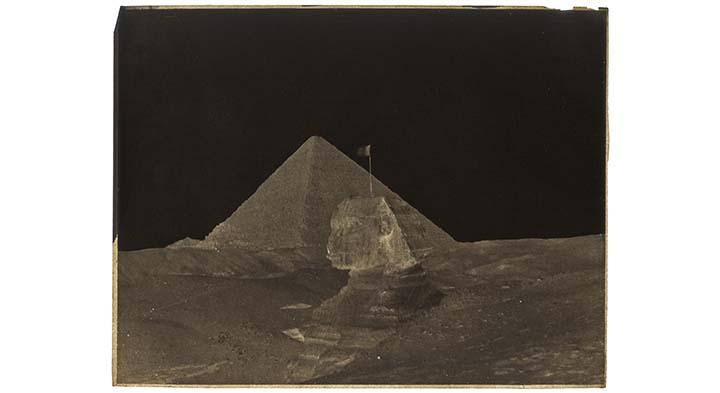Archive Fever: John Beasley Greene
Starting with Francis Frith (1822-1898), soon after the introduction of the daguerreotype in 1849, photography, antiquity and tourism became so interlinked as to shape Western ideas about non-Western cultures. Because of the tremendous public fascination with Egypt following the Napoleonic wars, the Valley of the Kings became the site of the first experiments in mass tourism, and photography was a major factor in the marketing of these tours—and the preservation of travelers’ “memories” of exotic places. Above: John Beasley Greene, Sphinx and Pyramid, Necropolis of Memphis, Giza, 1853-1854, waxed paper negative with selectively applied pigment, courtesy Hans P. Kraus Jr. | Fine Photographs
This was well before George Eastman launched the first Kodak (1888), with the sales pitch, “You press the button. We do the rest.” Until then, scenes of distant lands were created almost according to a formula designed to generate as much tourist traffic as possible. In fact, many archeologists financed their expeditions through the sales of photo albums of the major tourist attractions to tour organizers such as Thomas Cook; and many of these views, carefully composed into memorable scenes, unwittingly became false historical documents.
Tourists were guided to specific sites, traveled on boats designed to be as European as possible, stayed in hotels modeled on English counterparts, and were carefully guided along routes designed to screen out as much local color as possible. You could almost say there was an Egypt industry of model experiences based on preferred “views”. One might also wish that there had been a doppelganger of Martin Parr on the scene…
But there was a young American photographer, John Beasley Greene (1832-1856), who recognized Egypt and the Holy Land as sites for discovery as well as the most likely climate for restoring his failing health. Born in 1832 in Le Havre, France, to American parents, Greene was a student of the noted photographer Gustave Le Gray in Paris. In 1853, the 21-year old Greene made the first of two voyages to Egypt as a photographer and archaeologist. At that time, he documented Egyptologist Auguste Mariette’s excavations around the Great Sphinx of Giza. But he may have been drawn to the monuments and landscape as much as the dry desert air. As historian Eugenia Parry notes, “France was killing him. Not the culture. The climate. The ocean fog in Le Havre and the Paris rains added further torment to his congenitally infected lungs…Perhaps he began to think of Egypt as a kind of safe-house where he would have to live in order to live at all.”

In the catalogue of an exhibition of Greene’s work currently on view at Hans P. Jraus Jr. Fine Photographs, Parry continues, “Mid-19th century mania for life on the Nile may have also drawn Greene to Egypt, but once there he took in the endless expanse of sky and the wonder of the newly decipherable hieroglyphics and created majestic views. Among his photographs are images of Cleopatra’s Needle, the obelisk now situated in New York’s Central Park, and Pompey’s Pillar, a landmark to this day in Alexandria.”
Regarding his photographs of Constantine, an ancient city dramatically perched on a mountaintop in Algeria, Parry writes, “In the light of North Africa, he doesn’t exactly represent places, even when he records houses, ruined aqueducts, roads, bridges or burial sites…This late work is about feeling. At Constantine, dwellings on a stone mountain seem to be outcroppings of the rocks themselves. Encroaching shadows on disgorgements of stone near a Christian tomb fill the frame. It’s suffocating, even monstrous at times…Young Greene was close to dying. He wanted his pictures to look like how he felt.”
The abstraction that Greene brought to his landscape photography is unusual for his time, and seems almost foundational in terms of deconstructing the use of photography as an art form. Among the works on view at Hans P. Kraus are a number of Greene’s waxed paper negatives, which are displayed backlighted, as if being viewed on a light table. In negative form, the artist's carefully studied penchant for abstraction becomes even more evident. The beautifully executed catalogue includes positive prints for comparison.
John Beasley Greene continues at Hans P. Kraus Jr. Fine Photographs through December 2. 962 Park Avenue, NY, NY Info



